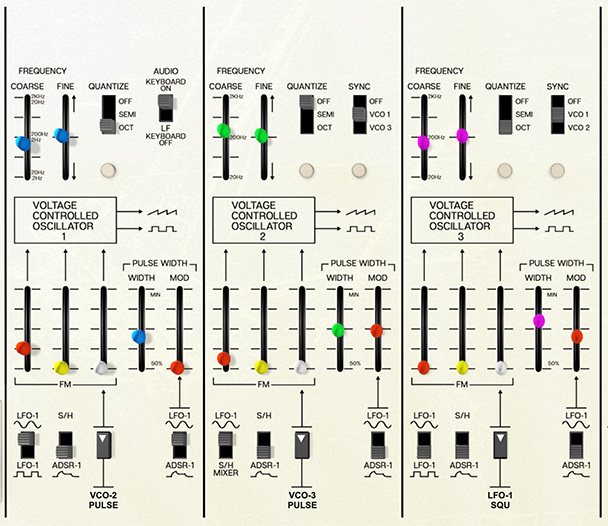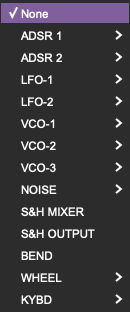The first big difference you'll notice between ODC 2800 and an original Odyssey is the addition of a third Voltage Controlled Oscillator (VCO). This immediately opens up a whole new realm of sound options – and if you're feeling purist, you can always elect to not use it. (So there.)
These VCOs are accurate models of vintage ARP oscillators, whose waveforms are rich with lovely-sounding imperfections. However, each VCO has one or more added features for more convenience, more flexibility, or both.
Coarse- Sets the fundamental frequency of the oscillator, displayed in Hz. The VCO frequencies range from around 20 Hz to 2 kHz. The exception is VCO 1, which has a wider frequency range when the Audio switch is set to LF Keyboard Off (see below).
Fine- You can tweak the VCO's pitch up and down with this slider, by 5.40 semitones – a bit over a 5th. The resolution here is in increments of cents (0.01 semitone).
Quantize- Here's a feature that Odyssey users would have loved! Rather than trying to tune each VCO precisely by dragging the Coarse slider over its full range, you have the option of setting it to jump by semitones or octaves.
Audio (VCO 1 only)- This switch lets you set VCO 1 to play notes at appropriate pitches from a keyboard, or to turn keyboard control off for drones or control signals at set frequencies. When LF Keyboard Off is set, the Coarse control ranges from about 0.2 Hz to about 20 Hz, turning VCO 1 into a second LFO when needed. (Well, actually a third LFO in ODC 2800 - unlike the original, the software has two Low-Frequency Oscillators.)
Note that just like an original Odyssey, the VCOs output two waveforms at once: rising sawtooth (ramp) and pulse. Which waveform you hear is chosen at the Audio Mixer inputs.
Sync (VCO 2 and VCO 3 only)- When turned on, the VCO is forced to restart its wave cycle based on the wave cycle of one of the other two VCOs. When two VCOs are not quite in tune, or out of phase, this forced reset turns the synced VCO's waveform into something more complex, with lots of extra harmonic content. Modulating the frequency of the control oscillator causes the harmonic content to shift over time, creating a powerful sweep sound. The main melody of The Cars' "Let's Go" is a great example of this.
FM- stands for frequency modulation, and these three sliders control how much FM is applied to the VCO from other sources. Depending on the modulation source, this can produce everything from wah and vibrato (FM using envelopes or LFOs) to drastic changes in timbre (FM using other VCOs, also called cross modulation).
Note that cross modulation is unique to ODC 2800; this wasn't possible on the original Odyssey because there were no routings in place to make it happen. Not a problem here, though!
Each VCO has its own set of default FM sources for the first two sliders:
VCO 1 FM 1 can use LFO 1's sine wave or square wave output
VCO 1 FM 2 can be Sample/Hold or ADSR 1
VCO 2 FM 1 can be LFO 1's sine wave output or the S/H Mixer output
VCO 2 FM 2 can be S/H or ADSR 1
VCO 3 FM 1 and VCO 3 FM 2 offer the same options as VCO 1

